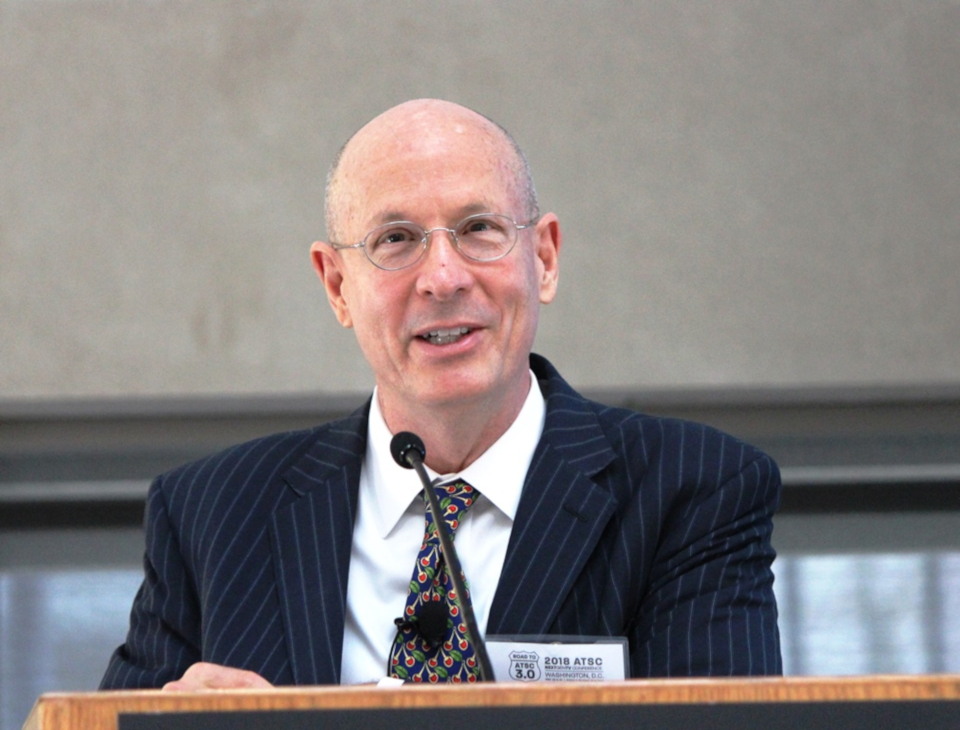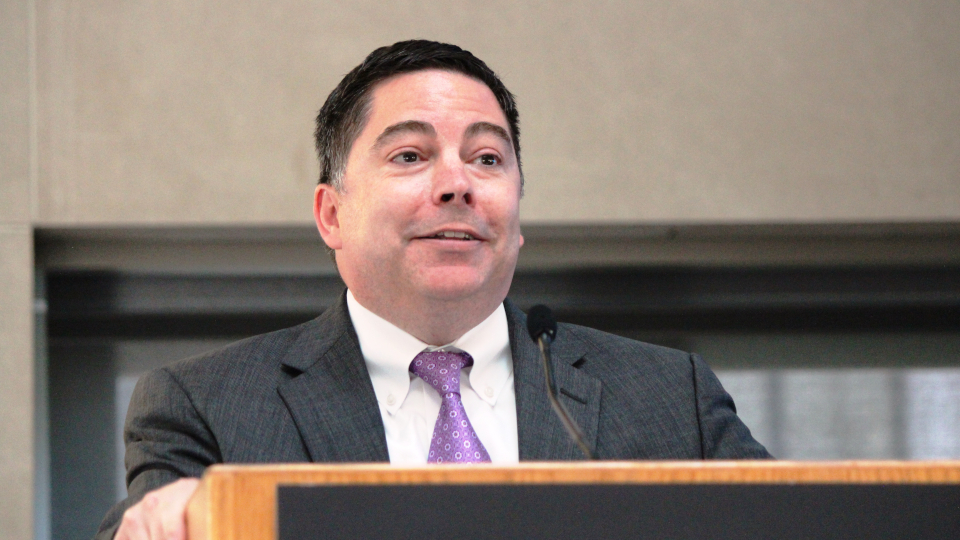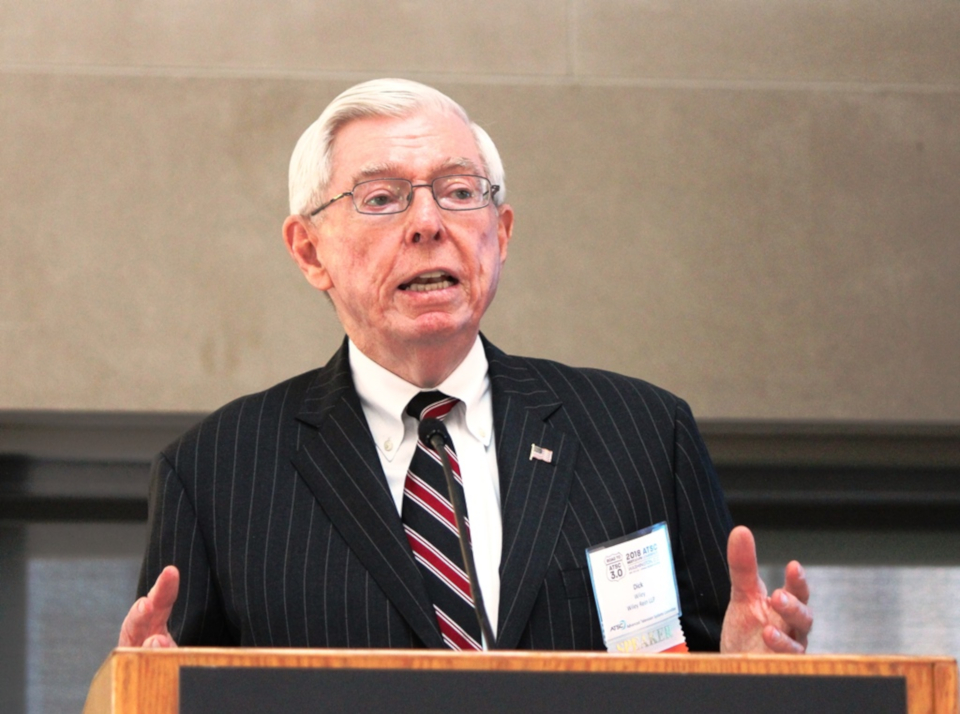Hane: ATSC 3.0 Can Shield TV Broadcasters From Future Spectrum Grabs

WASHINGTON — John Hane, president of Spectrum Co., isn’t quite sure whether it’s a bad dream or he’s a bit paranoid, but he’s seen this all before. Hane senses TV spectrum is at risk from another round of givebacks, and that ultimately there will be nothing left but VHF.
“Does it seem to anyone else that every 10 years or so we lose a really big chunk of spectrum?” he asked May 24 at the Advanced Television Systems Committee annual meeting at the Ronald Reagan Building in Washington.
“PROGRESSIVE RECLAMATION”
During his 20-minute talk, Hane recalled the “progressive reclamation” of TV spectrum broadcasters have suffered at the hands of lawmakers and regulators. “In 1983, the FCC reallocated channels 70 to 83, the 800 MHz band, for land mobile. That spectrum was given away to large companies. Given away,” he emphasized.
In the late 1990s, the agency developed a plan to reallocate channels 52 through 69 — the 700MHz band — for cellular service, and once the analog-to-DTV conversion was complete, broadcasters lost those channels.
“And just now, we are in the process of clearing out another 84MHz, but we’ve really lost more than that because the repacking algorithm — TV Study — really bunched us closer together so we have less breathing room,” said Hane.
While no auctions are planned at the moment, Hane reminded his audience that few saw the incentive auctions coming. Further, even without a new giveback, deep-pocketed, politically connected companies like Microsoft are trying to nail down broadcasters to their UHF assignments to make way for unlicensed white space devices.
Get the TV Tech Newsletter
The professional video industry's #1 source for news, trends and product and tech information. Sign up below.
“We need to put an end to the cycle of losing spectrum,” he said, as the crowd broke into applause. “Because ultimately without spectrum we don’t really have much of a business.”
ATTRACT NEW STAKEHOLDERS
The ATSC 3.0 standard is how broadcasters break the cycle of spectrum surrenders because it enables TV broadcasters to use their spectrum more intensely, he said. However, it’s a mistake to think of intense TV spectrum usage simply as a matter of attracting more over-the-air viewers, which Hane is convinced will happen due to Next-Gen TV’s reliable OTA reception, 4K UHD images and immersive sound.
“With 3.0, we increase the stakeholders in OTA broadcasting by reaching more people directly and by building new businesses,” said Hane. “We have to provide a range of services to a range of different stakeholders, and bring more stakeholders into the ecosystem to protect it.”
Some of those new services include data delivery to help power the Internet of Things and new automotive applications. Broadcasters will be deploying 3.0 to a market that is growing from a few hundred million handheld devices to a few hundred billion IoT and automotive devices, he said.
[Read: DISH Teams Up With Spectrum Co. on Next Gen TV Trial in Dallas]
“We are just at the beginning of the wireless revolution … It is a big market,” he said. However, that’s not to say that broadcasters will become “full-up competitors” with AT&T, Verizon and T-Mobile. “Our platform will be unique in its capabilities as how it is brought to the market,” he said.
The signal strength single-frequency networks can deliver throughout a market is a key part of reliable data delivery to support these new applications. Hane did not call for an immediate nationwide deployment, but said that SFNs have “to be on our planning horizon for our data customers, for our core service, for a market mobility” and to demonstrate broadcasters’ desire to use their spectrum “in an intense way and make money on it and bring other stakeholders in …”
Indeed, one of Spectrum Co.’s core missions is aggregating a critical mass of ATSC 3.0 bit capacity to support these types of new services, he said. “Because the market for communications services is national, we have to work together to compete in non-broadcast services.”
To the extent this business case develops, broadcasters will want to deploy SFNs, up their signal levels and push out their coverage areas, he said. “We have to work together because no broadcaster’s business is big enough to do that by itself.”
If successful in creating new services, including mobile, the revenues generated “can easily justify the cost of supplementing” big stick OTA delivery with SFNs over time — “not first out of the box,” he said.
But don’t wait too long, he cautioned, because wireless competitors covetous of broadcast spectrum and companies like Microsoft that wish to deploy services in white spaces are not going to wait for broadcasters. “They are going to try to take it away and pin us in while we are not doing it [deploying ATSC 3.0], and that is one of the main reasons why we need to move quickly,” said Hane.
“By upgrading our technology, working together to build new businesses [and] bringing in new stakeholders, we stay relevant and make more money,” he said.
O’RIELLY: “TIME IS NOT A LUXURY”
Hane was not the only speaker at the annual ATSC meeting to urge broadcasters to hasten their Next Gen TV deployment. FCC Commissioner Michael O’Rielly, a surprise speaker at the event, also encouraged broadcasters to move forward in an expeditious manner with their 3.0 rollouts.

O’Rielly, who visited Phoenix to see the “consumer-centric” 3.0 model market project being led by Pearl the week before the ATSC meeting, said time is not a luxury for broadcasters when it comes to Next Gen TV deployment.
“Television broadcasters are under enormous pressure right now, right here,” said O’Rielly. “The high-tech companies who broadcasters compete with daily for advertising and consumer attention are not going to stop and wait for ATSC 3.0 to be fully deployed.”
To make his point, O’Rielly recalled the story of a local car dealer who today on average gets 84 solicitations to advertise per month — the majority of which are from new digital outlets — where a few years ago he received only a handful from local stations. “If you are a broadcaster sitting on a fence [about] whether or not to deploy ATSC 3.0, you should be worried that the fence no longer exists if you take too long to decide.”

O’Rielly was introduced by former FCC Chairman Richard Wiley. Wiley was on hand to celebrate the 25th anniversary of the formation of the Grand Alliance, which included AT&T, General Instruments, MIT, Philips, Thomson, Zenith and the David Sarnoff Research Center and was responsible for development of the world’s first digital HDTV broadcast system.
“It was an intrepid assemblage of video pioneers who brought to the nation the wonders of widescreen, high definition television that’s been enjoyed by millions and millions of our fellow citizens over the past 25 years — at least,” said Wiley, who served as chairman of the advisory committee tasked by the FCC at the time with finding a path to advanced television.
“As revolutionary as the Grand Alliance and ATSC 1.0 was and still is, we stand today on a threshold of an even greater digital era.” Wiley said. “Of course, that is Next Gen digital television. So, today, we can celebrate and honor the past and present and look forward with great anticipation to what lies ahead.”
For a comprehensive list of TV Technology’s ATSC 3.0 coverage, see our ATSC3 silo.
Phil Kurz is a contributing editor to TV Tech. He has written about TV and video technology for more than 30 years and served as editor of three leading industry magazines. He earned a Bachelor of Journalism and a Master’s Degree in Journalism from the University of Missouri-Columbia School of Journalism.

